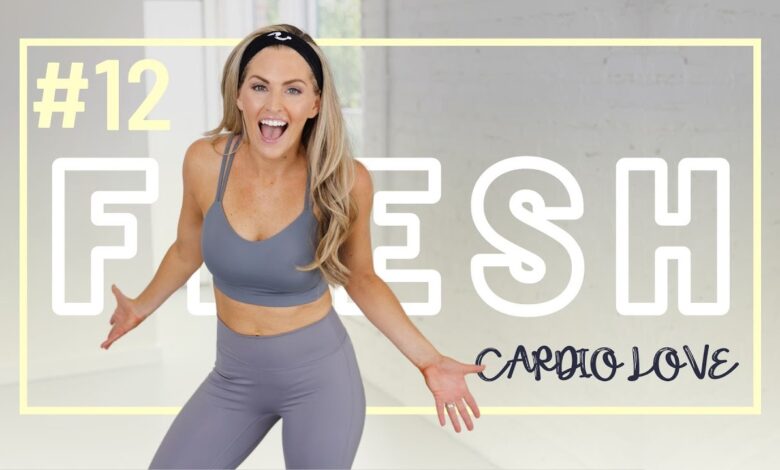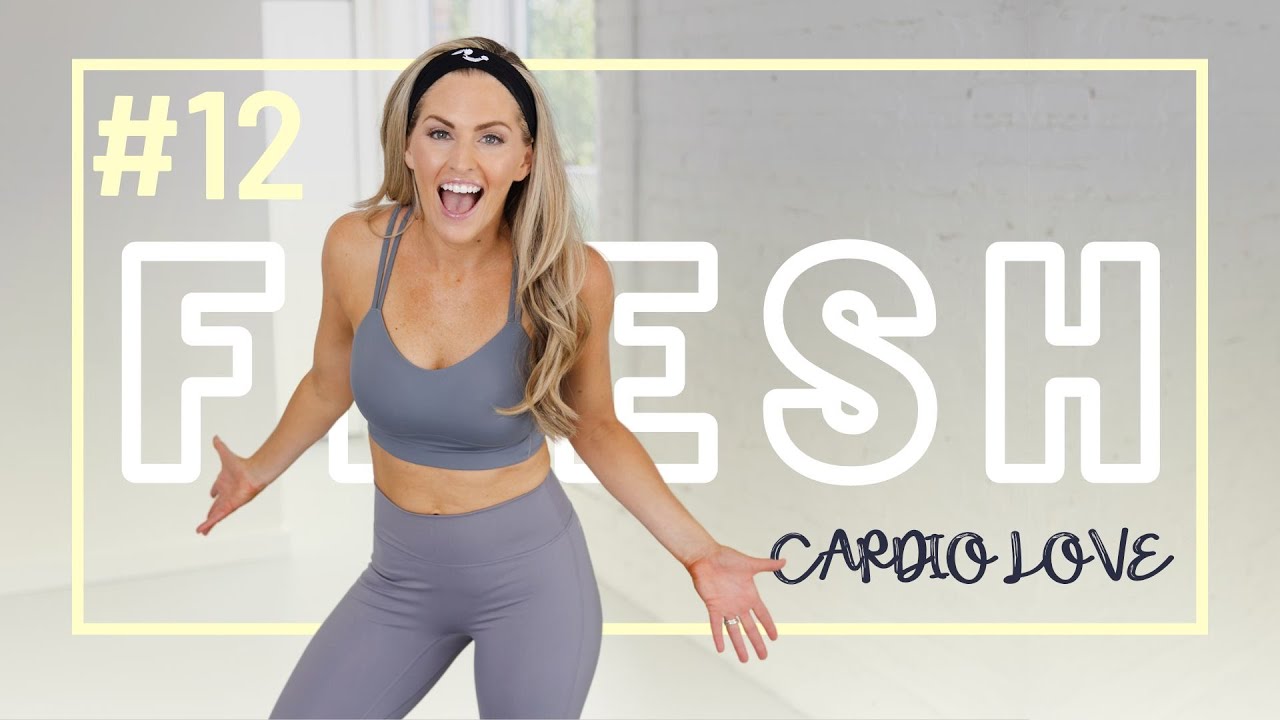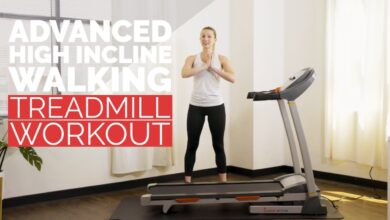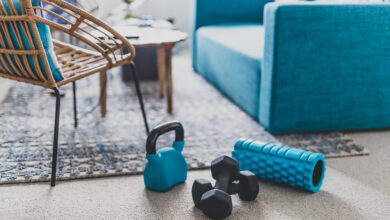
Ways to Learn to Love Cardio: Make Exercise Enjoyable
Ways to learn to love cardio is a journey that starts with understanding its benefits and finding the right activity for you. Cardiovascular health is essential for a long and healthy life, and incorporating cardio into your routine can have a profound impact on your well-being.
Whether you’re a beginner or a seasoned athlete, there’s a cardio activity out there for you. The key is to find something that you enjoy and that fits your lifestyle.
This guide will explore the different types of cardio, provide tips for getting started, and offer strategies for staying motivated. We’ll also discuss the importance of listening to your body and seeking professional guidance when needed. By following these steps, you can transform your relationship with cardio from dread to delight.
Understanding Cardio and its Benefits: Ways To Learn To Love Cardio
Cardiovascular exercise, often referred to as “cardio,” is an essential component of a healthy lifestyle. It involves activities that elevate your heart rate and improve your cardiovascular system, which is responsible for transporting oxygen and nutrients throughout your body.
Importance of Cardiovascular Health
Maintaining a healthy cardiovascular system is crucial for overall well-being. A strong heart and efficient blood circulation are vital for supporting various bodily functions, including:
- Delivering oxygen to muscles and organs.
- Removing waste products from the body.
- Regulating blood pressure.
- Preventing heart disease, stroke, and other cardiovascular conditions.
Regular cardiovascular exercise strengthens the heart muscle, improves blood flow, and lowers the risk of developing these serious health issues.
Types of Cardiovascular Exercises
There are numerous types of cardiovascular exercises, each offering unique benefits and challenges. Here are some common examples:
- Aerobic Exercise:This category includes activities that involve continuous, rhythmic movements, such as running, swimming, cycling, and dancing. Aerobic exercise improves endurance and overall cardiovascular health.
- High-Intensity Interval Training (HIIT):This type of exercise involves short bursts of intense activity followed by brief recovery periods. HIIT is highly effective for burning calories and improving cardiovascular fitness in a short amount of time.
- Strength Training:While primarily focused on building muscle mass, strength training also has cardiovascular benefits. Exercises like squats, lunges, and push-ups elevate the heart rate and improve blood flow.
- Sports:Participating in team sports like basketball, soccer, or tennis provides a fun and engaging way to get cardiovascular exercise.
Benefits of Incorporating Cardio into a Fitness Routine
Integrating cardiovascular exercise into your fitness routine offers numerous advantages:
- Improved Cardiovascular Health:Cardio strengthens the heart muscle, improves blood flow, and lowers blood pressure, reducing the risk of heart disease, stroke, and other cardiovascular problems.
- Weight Management:Cardiovascular exercise burns calories, aiding in weight loss or maintenance.
- Increased Energy Levels:Regular cardio improves your body’s ability to utilize oxygen, resulting in increased energy levels and reduced fatigue.
- Improved Mood and Mental Health:Exercise releases endorphins, which have mood-boosting effects and can help reduce stress, anxiety, and depression.
- Enhanced Sleep Quality:Regular physical activity promotes better sleep patterns, leading to improved sleep quality and overall well-being.
Finding the Right Cardio Activity
Finding the right cardio activity is crucial for achieving your fitness goals and enjoying the journey. It’s about discovering something that resonates with you, challenges you, and keeps you motivated.
Factors to Consider When Choosing a Cardio Activity
When choosing a cardio activity, several factors come into play. These include your fitness level, personal preferences, and any health conditions you may have. It’s also essential to consider the time commitment you’re willing to make and the availability of facilities or equipment.
Types of Cardio Activities
There are many different types of cardio activities, each with its unique benefits and drawbacks. Here’s a breakdown of some popular options:
Low-Impact Cardio
Low-impact cardio exercises are gentler on your joints and are suitable for people of all fitness levels. Here are some examples:
- Walking:Walking is a great way to get your heart rate up and burn calories. It’s also a low-impact activity that’s easy on your joints. You can walk indoors on a treadmill or outdoors.
- Swimming:Swimming is a great full-body workout that’s also low-impact.
It’s a good option for people with joint pain or injuries.
- Cycling:Cycling is a great way to get your heart rate up and burn calories. You can cycle indoors on a stationary bike or outdoors.
- Elliptical Trainer:The elliptical trainer is a low-impact machine that provides a full-body workout.
It’s a good option for people who want to avoid the impact of running.
- Yoga:While not traditionally considered cardio, some yoga styles, like Vinyasa and Ashtanga, can be quite challenging and raise your heart rate.
High-Impact Cardio
High-impact cardio exercises are more strenuous on your joints. These activities are often more intense and can help you burn more calories in a shorter amount of time. Some examples include:
- Running:Running is a great way to get your heart rate up and burn calories. It’s also a good way to improve your cardiovascular fitness.
- Jumping Jacks:Jumping jacks are a classic high-impact exercise that can be done anywhere. They’re a great way to get your heart rate up quickly.
- Burpees:Burpees are a full-body exercise that combines a squat, push-up, and jump. They’re a great way to challenge your cardiovascular system and build muscle.
- Kickboxing:Kickboxing is a great way to get a full-body workout while having fun. It’s a great way to relieve stress and improve your coordination.
Tips for Choosing the Right Cardio Activity
Here are some tips for choosing a cardio activity that’s right for you:
- Consider your fitness level:If you’re new to exercise, start with a low-impact activity like walking or swimming. As you get fitter, you can gradually increase the intensity.
- Think about your preferences:Do you prefer working out indoors or outdoors? Do you enjoy group classes or solo activities?
- Try different activities:Don’t be afraid to experiment with different activities until you find one you enjoy.
- Listen to your body:If you’re experiencing pain, stop the activity and consult with your doctor.
Starting Your Cardio Journey
Embarking on a cardio journey can be an exciting and rewarding experience, but it’s essential to start slowly and gradually increase the intensity to avoid injuries and burnout. Remember, consistency is key, so aim for a sustainable routine that fits your lifestyle.
A Gradual Approach
Starting slowly and gradually increasing intensity is crucial for a successful cardio journey. This approach allows your body to adapt to the new demands and reduces the risk of injuries.
- Begin with shorter sessions:Start with 10-15 minutes of cardio, 2-3 times a week. As you feel more comfortable, gradually increase the duration and frequency.
- Choose a low-impact activity:Walking, swimming, or cycling are excellent choices for beginners as they put less stress on your joints.
- Listen to your body:Pay attention to any signs of fatigue or pain. If you experience discomfort, reduce the intensity or duration of your workout.
Sample Beginner’s Cardio Workout Plan
Here’s a sample beginner’s cardio workout plan you can follow:
- Warm-up (5 minutes):Start with light cardio, such as walking or marching in place, to prepare your body for the workout.
- Cardio (20 minutes):Choose an activity you enjoy, such as brisk walking, cycling, or swimming. Maintain a moderate intensity level where you can still hold a conversation.
- Cool-down (5 minutes):Gradually reduce your intensity and finish with light stretching to help your body recover.
Staying Motivated and Avoiding Burnout
Staying motivated and avoiding burnout is essential for long-term success.
- Find an activity you enjoy:The key to sticking with cardio is finding something you genuinely like. Experiment with different activities until you discover one that keeps you engaged.
- Set realistic goals:Don’t try to do too much too soon. Start with small, achievable goals and gradually increase the intensity and duration as you progress.
- Make it social:Exercise with a friend or join a group fitness class to add a social element and keep you accountable.
- Reward yourself:Celebrate your milestones and achievements to stay motivated.
Making Cardio Enjoyable

Cardio can be challenging, but it doesn’t have to be a chore. Making it fun can help you stay motivated and stick with your fitness goals. Here are some tips to make cardio more enjoyable:
Finding a Workout Buddy or Joining a Fitness Class
Working out with a friend or in a group setting can make cardio more enjoyable and motivating. A workout buddy can provide encouragement, accountability, and a sense of camaraderie.
- Accountability:Knowing someone is expecting you to show up for your workout can help you stay on track.
- Motivation:Having a workout partner can make exercising more fun and less intimidating.
- Social Interaction:Exercising with a friend or in a group setting can help you stay engaged and make the time pass faster.
Fitness classes offer structured workouts with a group of people, which can be motivating and provide a sense of community. They also offer the benefit of learning from an experienced instructor.
Incorporating Music and Entertainment
Music can be a powerful tool for boosting motivation and making cardio workouts more enjoyable. Listening to your favorite tunes can distract you from the effort and help you push through challenging workouts.
Learning to love cardio can be a journey, but it’s worth it! Finding the right activities and focusing on progress over perfection can make a big difference. However, it’s important to be aware of thinking traps to avoid when trying to lose weight , like comparing yourself to others or setting unrealistic goals.
Remember, your journey is unique, and celebrating small victories along the way can keep you motivated to reach your fitness goals!
- Create a Motivating Playlist:Choose music that you enjoy and that has a good beat to help you keep pace.
- Listen to Podcasts or Audiobooks:If you prefer listening to something other than music, podcasts or audiobooks can provide entertainment and distraction during your workouts.
- Watch TV or Movies:If you’re working out at home, you can watch TV or movies to keep yourself entertained.
Ways to Make Cardio Fun and Engaging
Here’s a table showcasing various ways to make cardio fun and engaging:
| Method | Description |
|---|---|
| Dance Classes | Learn new dance moves while getting a great cardio workout. |
| Sports Teams | Join a recreational sports team for a fun and social way to get exercise. |
| Outdoor Activities | Go for a hike, bike ride, or swim in a lake or ocean. |
| Virtual Reality Games | Play active video games that use your body as a controller. |
| Group Fitness Classes | Attend Zumba, spin, or other group fitness classes for a motivating and energetic workout. |
Staying Consistent with Cardio
Consistency is the key to reaping the full benefits of cardio exercise. It’s not about doing a single intense workout and expecting to see results overnight. Instead, it’s about building a sustainable routine that you can stick with over the long term.
Setting Realistic Goals
To maintain a consistent cardio routine, setting realistic goals is crucial. Starting too ambitiously can lead to burnout and discouragement. It’s better to begin with small, achievable goals and gradually increase the intensity and duration of your workouts.
For example, if you’re new to cardio, aim for 15-20 minutes of moderate-intensity exercise three times a week. As you get fitter, you can gradually increase the duration or intensity. Remember, progress takes time and consistency.
Cardio for Different Fitness Levels
Cardiovascular exercise, or cardio, is an essential part of a healthy lifestyle. It strengthens your heart and lungs, improves blood circulation, and helps you maintain a healthy weight. But finding the right cardio workout can be tricky, especially if you’re just starting out or are returning to exercise after a break.
This is where understanding your fitness level comes in.
Adjusting Cardio Workouts for Different Fitness Levels
Adjusting your cardio workouts based on your fitness level is crucial for maximizing benefits and preventing injuries. Here’s how to tailor your routine for beginners, intermediate, and advanced levels:
Beginners
Beginners should focus on low-intensity activities and gradually increase duration and intensity. Start with short sessions of 10-15 minutes, 2-3 times a week. Choose activities that you enjoy and can sustain without feeling overwhelmed.
Intermediate
Intermediate exercisers can increase the duration and intensity of their workouts. Aim for 30-45 minutes of moderate-intensity cardio, 3-5 times a week. You can also incorporate interval training, alternating between high-intensity bursts and rest periods.
Advanced
Advanced exercisers can push their limits with high-intensity workouts, longer durations, and challenging activities. Aim for 60 minutes or more of high-intensity cardio, 4-6 times a week. Consider incorporating advanced techniques like HIIT (High-Intensity Interval Training) or circuit training.
Comparing Cardio Options for Different Fitness Levels
Here’s a table comparing different cardio options suitable for various fitness levels:| Activity | Beginner | Intermediate | Advanced ||—|—|—|—|| Walking | 15-20 minutes at a moderate pace | 30-45 minutes at a brisk pace | 60 minutes or more at a fast pace, incorporating hills || Jogging | 10-15 minutes at a slow pace | 20-30 minutes at a moderate pace | 45 minutes or more at a fast pace, including interval training || Swimming | 20-30 minutes at a leisurely pace | 30-45 minutes at a moderate pace, using different strokes | 60 minutes or more at a vigorous pace, incorporating drills and sprints || Cycling | 15-20 minutes at a comfortable pace | 30-45 minutes at a moderate pace, including hills | 60 minutes or more at a fast pace, including interval training and longer rides || Dancing | 15-20 minutes to upbeat music | 30-45 minutes to a variety of dance styles | 60 minutes or more of high-intensity dance classes |
Adjusting Intensity and Duration Based on Individual Needs
Remember, the key is to find a level that challenges you without pushing you beyond your limits.* Intensity:You can adjust the intensity of your workout by changing your pace, resistance, or incline. For example, you can increase the speed of your walk, add more weight to your resistance training, or increase the incline on the treadmill.
Duration You can also adjust the duration of your workout by increasing the time you spend exercising. For example, you can walk for 30 minutes instead of 20 minutes, or jog for 20 minutes instead of 15 minutes.
Remember, it’s essential to listen to your body and adjust your workouts accordingly.If you experience pain or discomfort, stop and rest. Consult a healthcare professional if you have any concerns.
Incorporating Cardio into Daily Life
Cardio doesn’t have to be confined to the gym. You can easily weave it into your daily routine and make it a part of your lifestyle. Incorporating cardio into everyday activities is a great way to boost your fitness without feeling like you’re doing a workout.
Taking the Stairs
Taking the stairs instead of the elevator is a simple way to get your heart rate up and burn calories. Climbing stairs is a great form of cardio, and it can be easily incorporated into your daily routine. Even if you take the elevator most of the time, try to take the stairs a few times a week.
Finding ways to love cardio can be a journey, but it’s worth it for the incredible benefits it brings. One of my favorite tricks for staying motivated is to reward myself with delicious, healthy meals after a good workout. And speaking of healthy and delicious, I recently discovered some amazing delicious ways to use chickpeas under 360 calories that are perfect for post-workout fuel.
Chickpea salad, anyone? It’s all about finding the right balance between pushing your limits and enjoying the process, and that includes rewarding yourself with yummy, nutritious food.
Climbing just one flight of stairs can burn as many calories as walking for 10 minutes.
Making Errands More Active
Running errands can be a great opportunity for cardio. You can easily turn your errands into a mini-workout by walking or biking instead of driving. Here are some tips:
- Park further away from your destination and walk the rest of the way.
- Walk or bike to the grocery store, the library, or the post office.
- Take a walk during your lunch break instead of sitting at your desk.
Active Transportation, Ways to learn to love cardio
Consider active transportation options like walking, biking, or rollerblading for short trips. This is a fun and effective way to get cardio in while running errands or commuting.
- Walking or biking to work or school can be a great way to start your day with a burst of energy.
- Cycling is a great option for longer commutes, and it can help you avoid traffic and save money on gas.
- Rollerblading is a fun and effective way to get cardio in while enjoying the outdoors.
The Role of Nutrition and Hydration
Cardiovascular exercise demands a lot from your body, and proper nutrition and hydration play a crucial role in optimizing your performance and ensuring a safe and enjoyable workout experience. Just like a car needs fuel to run, your body needs the right nutrients to power your cardio sessions and recover effectively.
Fueling Up Before and After a Cardio Workout
A well-balanced diet is essential for sustained energy levels during cardio workouts. The right foods can provide your body with the necessary fuel to power through your sessions. Here are some tips for fueling up before and after your cardio workouts:
- Pre-Workout Fuel:
- Choose complex carbohydrates like whole-grain toast, oatmeal, or fruit for sustained energy release.
- Include a small amount of protein, such as a handful of nuts or a protein shake, to support muscle recovery.
- Avoid sugary and processed foods that can cause energy crashes.
- Post-Workout Recovery:
- Replenish your glycogen stores by consuming carbohydrates, such as bananas, sweet potatoes, or rice.
- Prioritize protein intake to repair and rebuild muscle tissue. Good sources include lean meats, fish, eggs, and dairy products.
- Consider a post-workout snack that combines both carbohydrates and protein, such as a smoothie with fruit and protein powder.
Hydration for Optimal Performance
Staying hydrated is crucial for cardio performance. Dehydration can lead to fatigue, muscle cramps, and even heat exhaustion.
- Before Your Workout:Drink plenty of water in the hours leading up to your exercise session.
- During Your Workout:Sip water or a sports drink throughout your workout to replace fluids lost through sweat.
- After Your Workout:Replenish fluids by drinking water or an electrolyte-rich beverage.
Remember: The amount of water you need to drink will vary depending on the intensity and duration of your workout, as well as your individual body size and sweat rate.
Listening to Your Body
Cardio is a fantastic way to improve your health and fitness, but it’s crucial to remember that your body is your guide. Pushing yourself too hard can lead to injuries and burnout, hindering your progress. Instead, focus on listening to your body’s signals and adjusting your workouts accordingly.
Recognizing Fatigue and Pain
Recognizing fatigue and pain is crucial for preventing injuries and maximizing your cardio performance. It’s important to differentiate between normal muscle soreness and pain that indicates an issue.
Finding ways to love cardio can be a journey, but it’s worth it! Sometimes, a little motivation comes from the most unexpected places. For example, I recently found myself inspired by a list of 12 farmers market friendly asparagus recipes – the idea of fresh, seasonal ingredients made me want to get out and move! So, whether it’s a new recipe or a new playlist, keep searching for what sparks your joy and fuels your fitness goals.
- Normal Muscle Soreness:This is a common sensation after a workout, especially if you’re new to cardio or have increased your intensity. It usually feels like a dull ache and subsides within a few days.
- Pain:Pain that is sharp, stabbing, or persistent, especially if it doesn’t improve with rest, could be a sign of an injury. It’s important to listen to your body and stop the activity if you experience this type of pain.
Warm-Up and Cool-Down Routines
Warm-up and cool-down routines are essential for preparing your body for cardio and helping it recover afterward.
- Warm-Up:A warm-up gradually increases your heart rate and blood flow, preparing your muscles for activity. A good warm-up might include light cardio, such as walking or jogging, followed by dynamic stretches, like arm circles and leg swings.
- Cool-Down:A cool-down helps your body transition back to a resting state. It can include light cardio followed by static stretches, holding each stretch for 30 seconds.
Rest and Recovery
Rest and recovery are vital for optimal cardio performance. Allowing your body time to rest and repair is crucial for muscle growth and preventing injury.
- Rest Days:Incorporate rest days into your weekly routine. These days allow your body to recover and rebuild muscle tissue.
- Active Recovery:On rest days, consider light activities like walking or yoga to promote blood flow and reduce muscle stiffness.
- Sleep:Getting enough sleep is essential for recovery. Aim for 7-9 hours of quality sleep per night.
Seeking Professional Guidance
Embarking on a cardio journey can be both exciting and daunting. While the information readily available online can be helpful, nothing beats the personalized guidance of a qualified professional. Whether it’s a healthcare professional or a certified trainer, seeking expert advice can significantly enhance your experience and ensure you’re on the right track.
Benefits of Professional Guidance
Consulting with a healthcare professional or certified trainer offers numerous benefits, making it a worthwhile investment in your well-being. These professionals can provide personalized advice, identify potential risks, and offer ongoing support, ensuring your safety and maximizing your progress.
Personalized Advice and Support
A healthcare professional or certified trainer can tailor their recommendations to your specific needs, goals, and limitations. They’ll consider your medical history, fitness level, and any existing conditions to create a customized plan that’s safe and effective for you.
“Personalized guidance is essential for achieving sustainable results and avoiding potential injuries.”
Finding a Qualified Fitness Professional
Finding the right fitness professional is crucial for a successful cardio journey. Here are some tips to help you in your search:
- Credentials:Look for professionals with recognized certifications, such as a Certified Personal Trainer (CPT) or a Certified Exercise Physiologist (CEP). These certifications indicate they have undergone rigorous training and meet specific standards.
- Experience:Consider the professional’s experience working with individuals with similar goals and fitness levels as yours. This ensures they have the expertise to guide you effectively.
- Communication:Choose a professional who communicates clearly and effectively. You should feel comfortable asking questions and discussing your concerns openly.
- Referrals:Seek recommendations from friends, family, or healthcare providers. Personal referrals can provide valuable insights into a professional’s skills and approach.
Ending Remarks
Embracing cardio doesn’t have to be a chore. By understanding its benefits, finding an activity you love, and staying consistent, you can make exercise an enjoyable part of your life. Remember to listen to your body, seek professional guidance when needed, and celebrate your progress along the way.
With a little effort and the right approach, you can unlock the transformative power of cardio and reap the rewards of a healthier, happier you.





